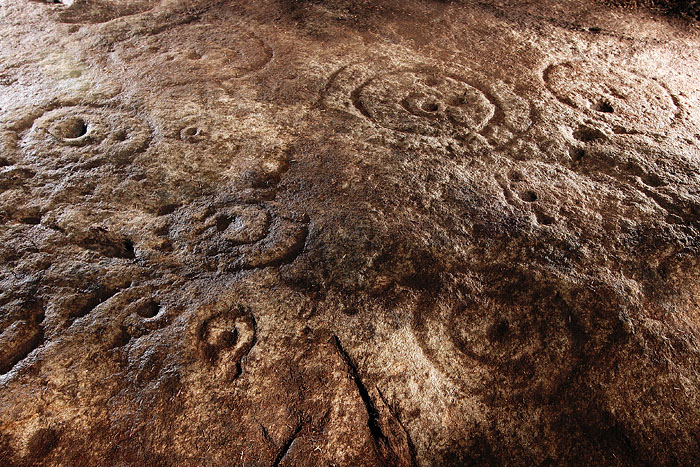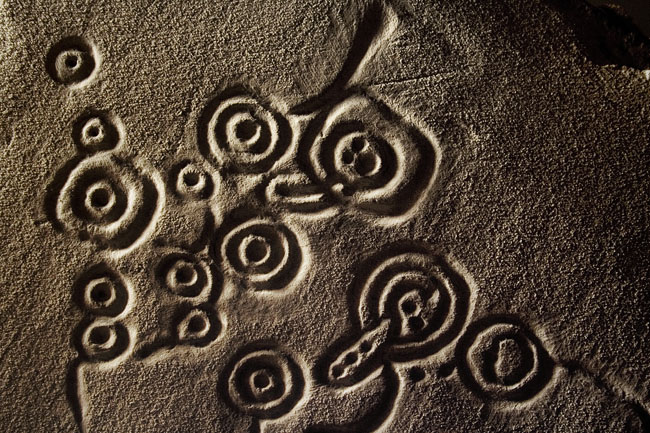
(After Beckensall, 2001)

(After Beckensall, 2001)


Forest clearing!



Gratuitous hdr shot ;)

An old school version of Amerside Panel No.1 with the carvings highlighted with water.
Not quite up to Hobs lush photo but it gives you an idea of what’s there.

Amerside Law 1
29/02/08

Amerside Law 1
07/03/08

Home made carving in miniature to try and show how the carvings might look (but when compared to Stan’s photos, you can see I’m being a bit over-hopeful...)
Amerside Law Panel 1
This panel is located in a small clearing within a densely packed conifer plantation. When Andy and Hob rediscovered this panel it was covered in a thick, dense mat of woodland crud which they spent a considerable amount of time clearing.
The panel is located on a rock outcrop; views from the panel are currently non-existent. If the plantation was removed, the main viewshed would be across the Till Valley to the distant Cheviot and surrounding hills.
The carvings themselves are much worn and were described by Stan Beckensall in the 1970’s. It was not possible to locate all of the features included in Stan Beckensall’s drawing of the panel. It appears that during the intervening years, a section of the carvings have disappeared completely, possibly due to damaged by forestry vehicles during the planting of the conifers.
Initially the carvings were quite difficult to make out, tracing their outlines with water helped bring the panel to life revealing a complex set of motifs. For me, one of the striking features of this and other panels is the asymmetrical nature of a number of the motifs. By this I mean that you have a large channel or double channel enclosing a number of cups, however, the cups are not evenly distributed but occur in one sector of the enclosed area or may even lay across the enclosing channel. This has always interested me, it is obviously a deliberate act and my personal opinion is that this strengthens the case for attaching a specific meaning to the motifs as opposed to purely an abstract design.
Managed to find these elusive carvings last week. It was decided that the choice of Feb 29th was auspicious, as it proved to be.
A bit of research via Google Earth showed a patch that looked to be in shadow, implying the existence of a clearing. A bit of tricknology with a gps device converted the GE co-ordinates into a gps friendly point at which to leave the path and follow the furrows made when planting the trees.
The trees have recently been thinned slightly in the southern part of the plantation, so access wasn’t as much of a problem as it could have been. Working out where the carvings are was, and we initially walked right past the spot where the carvings later showed up. This led to an hour or so of hands-and-knees crawling through some dense and highly resistant coniferous gloom.
A combination of the satellite images, Stan Beckensall’s sketched map and a bit of tree-stump observation eventually led to the conclusion that they were buried under a 25 yr old annoyingly deep and tangled pile of pine branches and needles. (It took much effort to shift the heap).
It was still a very sludgy bit of rock art, as the decades of decomposition had left an unpleasant slime mixed with pine needles over the surface of the outcrop. Hence a return visit today, this time armed with a (soft) brush and some water.
The carvings are very worn, but quite complex in composition. I couldn’t help but think it looked like a panel that had been added to over time, possibly starting out as a set of simple cups, elaborated upon at a later date.
If you take the trees away, there’s a great view, showing significant hills such as Ros Castle, Simonside and the Cheviot.
As far as I can work out, the lost carvings of Amerside Law have not been seen in over 25 years. the grid ref given here is only accurate to 100m, and is not likely to be of a lot of use to those of us used to entering co-ords into a gps and walking straight up to a panel of rock art. Note that the plantation is private, so any attempts must be with landowner permission.
They were first shown to Stan Beckensall by a local shepherd who tended his flock on horseback (what an excellent way to find rock art, up high, wandering over bleak moorland in the low sun of winter...). Since then, the area has been very heavily planted with conifers and subsequent attempts to locate the carvings have been unsuccessful. Stan does point out that at least one of the forestry workers recognised the value of preserving the carvings, and that trees were not planted right up to the marked outcrop. the problem is, the rest of the trees are so closely spaced, that it’s nigh on impossible to wander about looking.
However there are plans afoot to utilise new fangled technologies not previously available, to see if the dense shield of trees can be persuaded to relinquish the panel. We can but hope they are found before the trees are felled, as this might potentially damage the carvings (as no-one will know exactly where they are to avoid them)
Amerside Law on BRAC
Hobs wonderful account of the rediscovery of the Amerside carvings
Stan Beckensall’s old photos from the days before the trees were planted.
































































































































